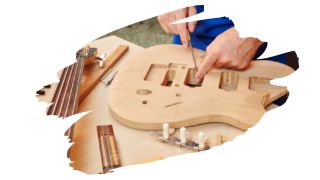As Rosewood becomes ever more difficult to source, other tropical hardwoods have started to take its place as an alternative for fretboards. For example, Purpleheart wood has begun to rise in popularity as an eye-catching substitute for Rosewood.
But, while this tropical hardwood stands out with its bold violet hue, is there more to it than meets the eye? And what can you do to keep a Purpleheart fretboard always looking its best?
Well, in this post, you’ll discover whether Purpleheart fretboards have more (or less) of an effect on the tone and playability of your guitar. You will also find out if Purpleheart needs a permanent finishing seal (and what will happen if you leave it unfinished).

This post may contain affiliate links to products that we receive a commission for (at no additional cost to you). Learn more here.
Does The Type Of Fretboard Wood Have Much Of An Effect On Playability?
No, it doesn’t. The type of finish you use on the fretboard has much more of an impact, (especially if that finish is ‘sticky’ to play).
Besides, a Purpleheart fretboard doesn’t impact string vibration. Rather, the shape of the guitar neck has a much greater effect on the thrum of those strings.
Does Fretboard Wood Matter When It Comes To Affecting Tone?
Somewhat, but the difference is so slight, your ears will struggle to pick up on it.
Instead, the type of wood used to make the guitar soundboard is the most impactful on tone.
So, Is Purpleheart Good For Fretboards?
Well, the main thing we look for in fretboard timber isn’t tone or playability. What we want is durability.
You see, if that fretboard can survive without the need for a finish, then that’s a great thing. As that means we can leave the fretboard unfinished (and in turn minimize the effect any finish has on playability).
This is one of many reasons why Rosewood and Ebony, (two very tough long-lasting hardwoods), are so popular for making this part of a guitar.
Now, Purpleheart wood absolutely fits the bill when it comes to being a durable wood. It is moisture-resistant (so a bit of humidity change isn’t going to crack it). And it is fairly tough.
Sure, it may not be as naturally oily as Rosewood (which is in a league of its own in that regard). Still, Purpleheart wood can do a great job as a more affordable alternative to Rosewood.
Related Post: What Can You Use As A Rosewood Fretboard Finish? (Revealed!)
And What Is The Best Conditioning Oil To Use On A Purpleheart Fretboard?
If that fretboard has been finished, (meaning it has been sealed with a durable water-repellent hard film), then it doesn’t need conditioning oils.
The durable film is already doing the job of a conditioning oil. It’s sealing the fretboard, preventing Purpleheart wood from drying out and cracking.
However, if your Purpleheart fretboard is unsealed, then it may need a sealing coat for two reasons; 1) To safeguard it from drying out, and 2) To maintain its bold purple coloring.
And What Happens When You Don’t Seal Purpleheart Wood?
Purpleheart is sturdy enough that it can naturally resist rot and decay. However, without a sealing finish, the color of this wood will turn from purple to a dark brown.
That’s because oxygen in the air will oxidize Purpleheart wood (pretty much from the moment this lumber is cut from the tree). And this oxidization process will leech the purple from purpleheart over time.
Related Post: Beginners Guide To Finishing Purpleheart Wood
What About Unfinished Fretboards? What Conditioning Oil Can You Use On Them?
While finished fretboards come ready sealed, unfinished fretboards have no such protection. This is often the case when a fretboard is made from a durable wood such as Rosewood, Ebony, and Roasted Maple.
In which case, we use a conditioning oil to ‘rehydrate‘ the wood grain of these fretboards, before they have a chance to completely dry-out.
This is called conditioning the fretboard. And the type of conditioning oil most frequently used to do this is 100% pure food grade mineral oil.
This non-drying, non-toxic oil has been made from super-refined petroleum distillate. It’s the key ingredient in a lot of fretboard ‘lemon’ oil products. And it is so safe that it can even be consumed, (although, fair warning, it’s used as a laxative not as a cooking oil!).
Every 6 to 12 months you should apply a tiny droplet of this non-drying oil between each fret, and rub it right into the grain. That’ll be enough to prevent Purpleheart from drying out.
What Is A Non-Drying Oil? A non-drying oil, (like Mineral Oil or Fractionated Coconut Oil), never dries, or leave behind a hard resin on the surface of wood. Drying oils, (like Linseed oil or Tung Oil), will dry and harden into a water-repellent resin on the surface of your fretboard.
To Wrap Up, Here Are The 3 Key Takeaways From This Post…
- 1). The type of fretboard wood your guitar uses has little impact on the playability or tone of your guitar.
- 2). Purpleheart wood is a durable wood that makes for a great alternative to Rosewood fretboards.
- 3). Finished fretboards don’t need conditioning. However, unfinished fretboards will need an light application of pure food grade mineral oil every 6-12 months.
